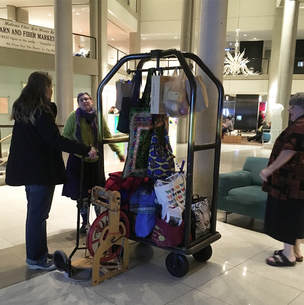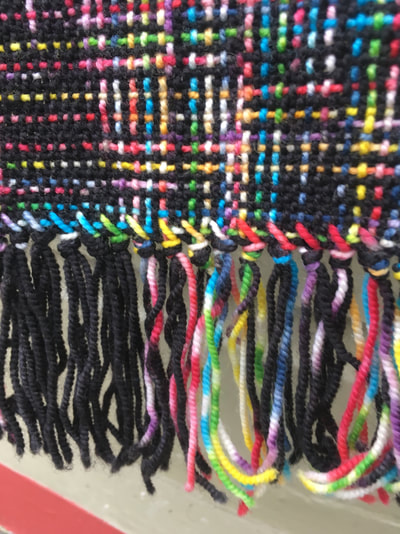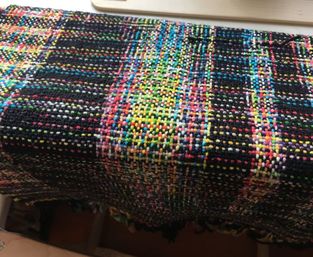|
Madrona Fiber Arts Winter Retreat is a weekend that I look forward to every year. I think it first crossed my radar when we were still living in Kansas - the Yarn Harlot (aka Stephanie Pearl-McPhee) blogged about it each year, and I thought that maybe one day I'd be good enough to go. We moved out to Stanwood in late 2012, and I went to Madrona for the first time in 2016. I was really surprised at how approachable many of the classes were and how wide a range of skill/experience levels were covered, and I started encouraging people to go. Last year I went with a friend. This year... well... let me show you a photo of us arriving at the hotel. (A deluxe double room at the Hotel Murano comfortably fits four adults, their bags upon arrival, and three full-sized spinning wheels. It starts getting crowded after everyone makes the first pass through the Madrona marketplace.) Our roommate group this year covers all craft areas, but our classes were all focused on spinning and weaving. Among the four of us, we took Designing Your Own Woven Bands (John Mullarkey), Spinning Notebook (Kate Larson), Gradient Spinning (also Kate Larson), Spinning for Norwegian Bandweaving (also also Kate Larson), Spinning for Weaving (Judith MacKenzie), Spinning Paper (also Judith MacKenzie), and Spinning Linsey-Woolsey (also also Judith MacKenzie). In talking with everyone over meals, drinks, and leisurely walks in frigid, windy weather, we were all really pleased with all of our classes. There was quite a bit of overlap, and I think we'll be comparing notes and touching base constantly over the next few months. Classes with Judith are always amazing and slightly more free-form than I anticipate, but here are some of the major takeaways:
No post on Madrona would be complete without a bit on the marketplace, but that shall have to wait until later in the shop weekend! Keep your eyes peeled for another post tomorrow or Monday. Until then - stay dry and warm, and happy crafting!
1 Comment
Last week on the blog, I wrote about the first iteration of the woven Rainbow Scarf and how it went very, very wrong. So let's turn it around and take a look at what went right the second time, plus lay out the planning process. The project started last fall when customers asked me to document a weaving project on the shop's Cricket rigid-heddle loom. Challenge accepted. I proposed four different colors of Sprout Sock from The Fiber Seed as possibilities and put the color choice up to a vote on Facebook and Instagram. The final winner was Rainbow in the Dark, a Dipped colorway - when put up into a twisted hank, Dipped colorways have a solid color on one half of the hank and speckles on the other side. Given this wild colorway, the project needed to be simple and let the yarn do the talking. I initially thought I'd just pair Rainbow in the Dark with a skein of Noir (just plain black). As I warped the loom, though, I saw that there was a real possibility for a cool experiment in planned pooling. Planned pooling is a way of calculating how the color runs in a variegated yarn will line up (or not) according to the width of the project and the size of hook/needle/reed used. (Want more information and a ton of examples? Check out this article by Karla Stuebing in Twist Collective, and then check out the Pooled Knits group over on Ravelry.) When I unhanked the yarn, I measured how long each color section was and ended up with about 14"/35.5 cm per section of black/rainbow speckle, with some variation due to the hand-dyeing and rehanking process. I was shooting for a longer scarf, so I decided to do a warp that would be a multiple of 14"/35.5 cm - I decided on 84"/2.13m. I also wanted to maximize the flashiness of the colorway, so I decided to make the warp 14"/35.5 cm wide - of course, I didn't write down how many ends that ended up being, but it was somewhere in the neighborhood of 140-150 ends in a 12-dent reed. As for the weaving itself, I decided on a plain-weave fabric. (Anything else in a busy shop seemed a little risky.) I wove this scarf with absolutely zero regard to draw-in or take-up or, really, any other aspect of finishing woven fabric; as a result, it's shorter than I would like. However, the color effect is so spectacular that I'm going to wear it anyway - just not in the long and loopy way that I would normally prefer. Because of how the colors on the skein intersected, there are some spectacular effects here - plaid, stripes, and pools of color alternating with pools of black that move back and forth down the length of the final scarf. The final step in the weaving process was to hemstitch and secure the fringe... I love hemstitching. Seriously. Finishing is such an important part of the process, and I love all of the steps. To do the final finishing of the project, I soaked the scarf in cool water and Eucalan for 30 minutes, spun out the excess water in the shop washer's spin cycle, and tossed it in the dryer. So - what would I do differently next time?
And that, gentle readers, is the story of the Second Rainbow Scarf! If you have questions, comments, or suggestions on this blog post - or if you've got ideas that you'd like to have me write about here! - please post a comment or drop me a line at Lindsey [at] stillyriveryarns [dot] com. Thanks for reading! I expect to have at least one new post up (if not two!) in about two weeks, after I come back from the Madrona Fiber Arts Winter Retreat. We won't be there as vendors, but we are going for a weekend of professional development and browsing the marketplace - can't wait to share with you then! |
AuthorLindsey Spoor is the owner of Stilly River Yarns in Stanwood, WA. Archives
April 2024
Categories |
Reach out! |
Come visit us at our brick-and-mortar shop in Stanwood!
NEW LOCATION STARTING JULY 16, 2024:
7104 265th St. NW Suite 120 Stanwood, WA 98292 Shop phone: (360) 631-5801 Email: [email protected] Text: (515) 833-0689 |
|
|
Proudly powered by Weebly
Stilly River Yarns LLC
Copyright © 2024
Copyright © 2024








 RSS Feed
RSS Feed